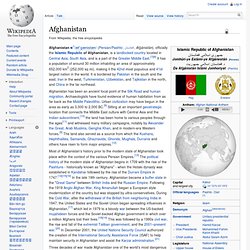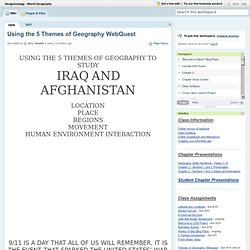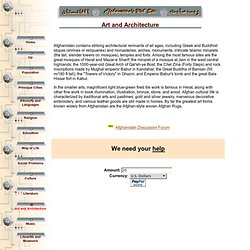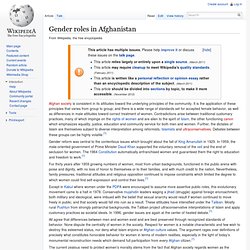

Afghanistan. Afghanistan i/æfˈɡænɨstæn/ (Persian/Pashto: افغانستان, Afġānistān), officially the Islamic Republic of Afghanistan, is a landlocked country located in Central Asia, South Asia, and is a part of the Greater Middle East.[7][8] It has a population of around 30 million inhabiting an area of approximately 652,000 km2 (252,000 sq mi), making it the 42nd most populous and 41st largest nation in the world.

It is bordered by Pakistan in the south and the east, Iran in the west, Turkmenistan, Uzbekistan, and Tajikistan in the north, and China in the far northeast. Afghanistan has been an ancient focal point of the Silk Road and human migration. Archaeologists have found evidence of human habitation from as far back as the Middle Paleolithic. Etymology The name "Afghaunistan" appearing on an 1847 lithograph by James Rattray.
The last part of the name, -stān is a Persian suffix for "place". Geography Topography. Geogranology - World Geography / Using the 5 Themes of Geography WebQuest. You are not restricted to using the following web resources.

They are listed merely as a starting point. Google is your friend, but be sure that any source you use is reputable. Be sure to copy and paste any and all URLs for the sources you use. Create a separate Resources page in your wiki... Location- is broken down into absolute location and relative location. Place - the study of place includes an examination of both the "human" place and the "physical" place. Google Image Result for. Afghanistan location. Afghanistan Guide. Welcome to Afghanistan Culture! Afghanistan - Language, Culture, Customs and Business Etiquette. Welcome to our guide to Afghanistan.

This is useful for anyone researching Afghan culture, customs, manners, etiquette, values and wanting to understand the people better. You may be going to Afghanistan on business, for a visit or even hosting Afghani colleagues or clients in your own country. Remember this is only a very basic level introduction and is not meant to stereotype all Afghanis you may meet! Facts and Statistics Location: Southern Asia, north and west of Pakistan, east of Iran Capital: KabulClimate: Arid to semiarid; cold winters and hot summers Population: 29,928,987 (July 2005 est.)Ethnic Make-up: Pashtun 42%, Tajik 27%, Hazara 9%, Uzbek 9%, Aimak 4%, Turkmen 3%, Baloch 2%, other 4% Religions: Sunni Muslim 80%, Shi'a Muslim 19%, other 1%Language in Afghanistan.
Afghan cuisine. Some of the popular Afghan dishes, from left to right: 1.

Lamb grilled kebab (seekh kabab); 2. Palao and salad; 3. Tandoori chicken; and 4. Mantu (dumplings). The Afghan cuisine includes a blend of Central Asian, Eastern Asian and Middle Eastern cuisines. Kabul influence on Afghan cuisine[edit] Untitled. Afghanistan location. Afghanistan Online: Holidays. The religious holidays in Afghanistan are celebrated according to the lunar calendar, and other holidays such as Independence day, and New Year's day are celebrated based on the solar calendar.

During many holidays, Afghans usually visit friends and families, prepare lavish meals, and attend special prayers. Day: After a month of Fasting (Ramadan). Many start out the day by wearing new clothes, and going to prayer. Afterwards, people visit or entertain their friends and families. Children usually receive gifts or money called "Eidi". Donate to/Sponsor Afghanistan Women Victims of War. Each time you vote, you fear for your life.

Your legal system does not protect you from violence and rape. If you try to go to school, you risk being attacked. This is today's Afghanistan. Google Image Result for. Afghanistan's Web Site - Afghanistan Art and Architecture. Afghanistan contains striking architectural remnants of all ages, including Greek and Buddhist stupas (shrines or reliquaries) and monasteries, arches, monuments, intricate Islamic minarets (the tall, slender towers on mosques), temples and forts.

Among the most famous sites are the great mosques of Herat and Mazar-e Sharif; the minaret of a mosque at Jam in the west central highlands; the 1000-year-old Great Arch of Qal'eh-ye Bost; the Chel Zina (Forty Steps) and rock inscriptions made by Mughal emperor Babur in Kandahar; the Great Buddha of Bamian (55 m/180 ft tall); the "Towers of Victory" in Ghazni; and Emperor Babur's tomb and the great Bala Hissar fort in Kabul. Gender roles in Afghanistan. Gender reform was central to the contentious issues which brought about the fall of King Amanullah in 1929.

In 1959, the male-oriented government of Prime Minister Daud Khan supported the voluntary removal of the veil and the end of seclusion for women. The 1964 Constitution automatically enfranchised women and guaranteed them the right to education and freedom to work.[1] For thirty years after 1959 growing numbers of women, most from urban backgrounds, functioned in the public arena with poise and dignity, with no loss of honor to themselves or to their families, and with much credit to the nation. Nevertheless, family pressures, traditional attitudes and religious opposition continued to impose constraints which limited the degree to which women could find self-expression and control their lives.[1] Except in Kabul where women under the PDPA were encouraged to assume more assertive public roles, this evolutionary movement came to a halt in 1978.
Consideration[edit] References[edit] Google Image Result for. Human rights in Afghanistan. The situation of Human Rights in Afghanistan is a topic of some controversy and conflict.

While the Taliban were well known for numerous human rights abuses, several human rights violations continue to take place in the post-Taliban government era. Post Taliban[edit] Torture Agreement[edit] In March 2002, ABC News claimed top officials at the CIA authorized controversial, harsh interrogation techniques.[3] The possible interrogation techniques included shaking and slapping, shackling prisoners in a standing position, keeping the prisoner in a cold cell and dousing them with water, and water boarding.[3] A United Nations study in 2011 reported on interviews with 379 detainees. It found those held by police or intelligence services were subjected to beatings, removal of toenails and electric shocks.[4] Elections during combat[edit] Several elections have been held in Afghanistan since 2001.